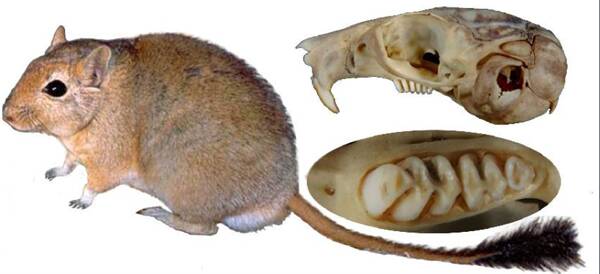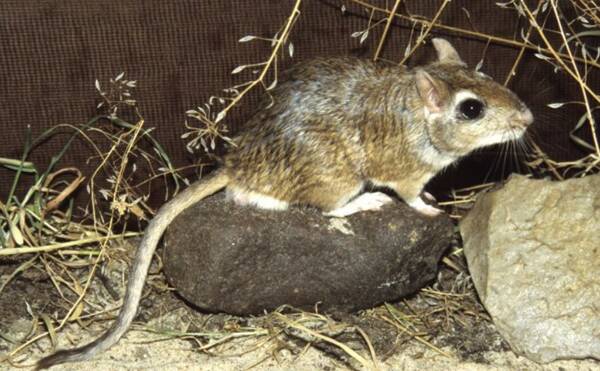Meriones tamariscinus
IUCN
LCBasic Information
Scientific classification
- name:Meriones tamariscinus
- Scientific Name:Meriones tamariscinus,Tamarisk gerbil,Sand rat
- Outline:Rodents
- Family:Rodentia Cricetidae Gerbil
Vital signs
- length:130-190mm
- Weight:80~90g
- lifetime:
Feature
It is large in size, has a short tail, short ears, and a brown back.
Distribution and Habitat
In China, it is distributed in Xinjiang, Gansu and Inner Mongolia. Abroad, it is distributed in Kazakhstan and Russia.
Tamarix gerbils live mostly in wetlands with good water conditions and lush vegetation. They generally choose river floodplains, bushes and moist areas with reeds and Achnatherum splendens in the desert, as well as areas with well-developed vegetation on both sides of the river as their habitats. They are also distributed in the desert steppes of Artemisia piedmont, oases on the edge of the basin, and the sides of ditches in agricultural areas, next to village houses, and fallow land.
Appearance
The individual is relatively large, with a body length of about 150mm (130-190mm). The tail is slightly shorter than the body length, about 130mm. The back of the body is brown, and the belly is pure white. The back of the tail is the same color as the back of the body, and the belly is white. There is a white spot from the upper edge of the eye to the front of the ear. There is a small brown spot on each side of the nose where the whiskers grow. Its characteristic is: there is a black stripe on the ventral surface of the hind foot, which runs through the entire ventral surface. On the skull, there is a longitudinal groove on the labial surface of the upper incisors, there are no premolars, and there are 3 molars. The chewing surface of the second molar is shaped like a "王" character, and the chewing surface of the second upper molar is shaped like a "工" character; the chewing surface of the third upper molar is oval.
Details
Tamarix gerbils belong to the Gerbillinae subfamily. The species-level classification status is stable, with 5 subspecies. Tamarix gerbils are the largest species of the genus Gerbil, mainly active in semi-desert meadows and grass, and also more in dry riverbeds and abandoned farmland. In the living environment, the grass height is generally about 1m, with a coverage of 80%-100%. They are good at digging the soil, and the burrows are densely distributed. In autumn, cut the grass into sections of about 5cm, dry it and store it. It is active at night.

Tamarix gerbils are strictly nocturnal animals. They start their activities at sunset and stop before dawn. They are also active at night in the severe winter when the snow is heavy. They are mainly foraging, and they are agile. They run in and out of many holes overnight, and the number of holes can reach more than 30. Reproduction and feeding activities are most active in spring and summer.
Tamarix gerbils live in burrows, and the burrow structure is relatively simple. The burrow entrances are mostly opened at the roots of bushes or on the slope of small terrain uplifts, and there is soil thrown near the burrows. The rat burrows are divided into temporary and residential burrows. Temporary burrows are very simple, with only 1~2 exits, few burrow branches, and no nest chambers. The first bend of the burrow trunk is usually relatively wide, often with food residues, mainly used to avoid enemies and eat. The residential burrow is more complex, divided into summer and winter use. The main burrow is inclined downward and can be as long as 6m, and it is divided into multiple branch burrows. In summer, the burrow has 2~3 entrances, the burrow has more branches, and there is a nest chamber about 1m deep from the ground, which is in the shape of a shallow basin. There are often food storage paths in the cave, which are blind paths and can be up to 35cm long. The wintering cave also has only 2~3 holes, but the nest is located 2m underground, and there are a lot of bedding in the nest chamber, almost filling the nest chamber. The caves of Tamarix gerbils generally exist alone, and it is rare to see 3~5 holes tied together, let alone forming dense cave groups.

Tamarix gerbils mainly feed on the green parts, seeds and fruits of various herbs and shrubs. Compared with other gerbils, they like to eat foods with higher water content. In early spring and late autumn and early winter, they also feed on animal food such as beetles and ants. Many kinds of crops and weeds in agricultural areas can also become their food. They have the habit of storing food in winter, including wheat, corn, wild oats, alfalfa, etc.
Tamarix gerbils begin to reproduce at the end of March every year and continue until late September, with 2 to 3 litters a year. The first peak of reproduction occurs in late April, and almost all overwintering female mice participate in reproduction. The second peak of reproduction is in July, with 3/4 of female mice participating. The lactation period is about 20 days, and each litter can have up to 10 pups, as few as 2, and an average of 4 to 7. The first batch of pups appeared on the ground at the end of May. About 60 days after the birth of the young mice, the individual weight reaches about 80~90g, which means that they reach sexual maturity and participate in the reproduction in autumn.

In my country, the population of Tamarix gerbils is relatively stable, and there has never been a major outbreak or sharp decline, and its number does not change much from year to year. After the breeding season each year, the population can increase by 2~3 times, and after the harsh conditions of the severe winter, it returns to normal levels. The capture rate of the clamp-day method in Xinjiang generally does not exceed 5%.
Listed in the 2008 IUCN Red List of Threatened Species ver 3.1 - Least Concern (LC).








